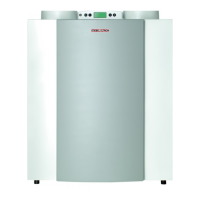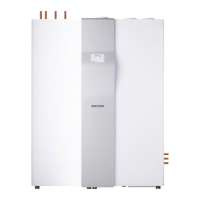21
connecting the heat pump. Debris, such as
welding pearls, rust, sand, sealant, etc. can
impair the operational reliability of the heat
pump, and can lead to the condenser being
blocked.
Filling the heating system
When filling the system with heating
water, observe VDI 2035, sheet 1 [or local
regulations]. In particular, this means that
during the service life of the system, the
total of the fill and top-up water must not
exceed three times the nominal volume of
the heating system,
the total alkaline earths in the water must
be < 3.0 mol/m³,
the total water hardness must
be < 3 mmol/l, and
soften the water, if the above conditions
cannot be met.
Generally soften the heating water, if the
specific system volume > 20 l/kW
output
(e.g. systems with buffer cylinder).
Venting the heating system
Air pockets in the system are detrimental to
the heat pump operation. Therefore, install an
air vent valve in the appropriate position.
Oxygen diffusion
Steel components, such as radiators and
pipes, can corrode if plastic underfloor heating
system pipes, which are permeable to oxygen,
are used.
The product of corrosion, i.e. rusty sludge, can
settle inside the heat pump condenser and can
result in a lower output through reduction of
cross-section or in a shutdown being activated
by the high pressure limiter.
Scaling
Water quality, operating conditions and the
water volume are decisive factors to the extent
of scaling. To prevent damage to valves, heat
exchanger and heating elements, check the
water condition and assess it in accordance
with VDI 2035 [or local regulations].
Note: An awareness of hardness in
accordance with the Detergent Act [Germany]
is insufficient. Decisive for scaling is the
concentration of calcium hydrogen carbonate,
which can be supplied by your water supply
company.
Flow noise
When flow noises occur which can be
attributed to the system, install a thermostatic
three-way valve at the end of the main line.
2.5.4 DHW connection
Fitting the plug-in connector
The plug-in connectors are equipped with a
retainer with stainless steel serrations and
an O-ring for sealing. In addition, they are
designed with the "Twist and secure" function.
By simply turning the screw cap manually,
the pipe is secured in the connector, and the
O-ring is pushed against the pipe to seal it.
Gap between the screw cap and the casing
(released position)
Making the connection
The fitting must be in its released state before
inserting the pipe. In this position, there is a
small gap between the screw cap and fitting
body.
Push the pipe past the O-ring until it bottoms
out inside the connector. Tighten the screw
cap unit it meets the casing. This presses
the O-ring against the pipe and secures the
connector.
Releasing the connection
Turn the screw cap back until a small gap
appears. Turn the retainer back by hand and
hold it in position. The pipe can now be pulled
out again.
Observe DIN 1988 and the regulations of your
local water supply company.
To protect against the risk of
corrosion, make the connection
as flat packing seal. The use of hemp on
connections is not acceptable.
We recommend the following combinations
when using metal pipework for the
installation:
Cold water line DHW line
Copper pipe Copper pipe
Steel pipe Steel or copper pipe
Insulate the DHW line in accordance with local
regulations.
Insulate the DHW line in accordance with local
regulations.
Please adhere precisely to the order of fittings
on the cold water side (see Fig. 9). Flush the
line prior to installation.
Install the safety valve into the cold water line.
The expansion water must be seen to be able
to drip into a basin or funnel.
Size the drain so that water can drain off, even
if the safety valve has been fully opened.
The outlet must not be able to be blocked/
closed off. The safety valve must open at 0.6
+0.1
MPa (6.0
+1
bar). Install a drain valve at the
lowest point of the cold water supply line.
Install a pressure reducing valve when the
water pressure exceeds 0.5 MPa
(5 bar). Special measures are required at
water pressure above 1.0 MPa (10 bar) (see
DIN 1988).
Connecting a DHW circulation line
The heat losses incurred in the circulation line
and the electrical power consumption of the
circulation pump reduce the efficiency of the
system. The cooled water in the circulation
line mixes with the cylinder content.
Where possible, avoid installing a DHW
circulation line. Where that is not possible,
control the DHW circulation pump thermally or
by time switch.
Condensate drain
Route the condensate from the cooling unit
to a drain via the factory-fitted 2 m long hose
(hose dia. 3/4").
The condensate must be able to drain
freely from the hose. The hose must
not show any signs of siphoning (this would
cause a malfunction of the siphon cap).
If necessary, install a condensate pump. The
DHW connection on the equipment must be
carried out as per Fig. 9.
2.5-5 Solar connection (SOL versions)

